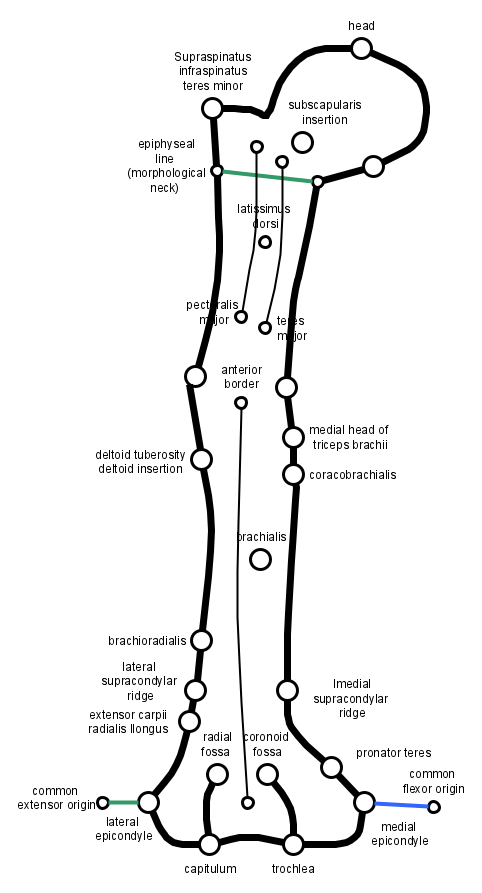HUMERUS
ANALOGY OF HUMERUS BONE
- HUMERUS
- Head
- Anatomical neck
- Surgical neck
- Greater tubercle
- Lesser tubecle
- Intertubercular sulcus; bicipital groove
- Crest of greater tubercle; lateral lip
- Crest of lesser tubercle; medial lip
- Shaft of humerus; body of humerus
- Anteromedial surface
- Anterolateral surface
- Posterior surface
- Radial groove; groove for radial nerve
- Medial border
- Medial supraepicondylar ridge; medial supracondylar ridge
- (Supracondylar process)
- Lateral margin
- Lateral supraepicondylar ridge; lateral supracondylar ridge
- Deltoid tuberosity
- Condyle of humerus
- Capitulum
- Trochlea
- Olecranon fossa
- Coronoid fossa
- Radial fossa
- Medial epicondyle
- Groove for ulnar nerve
- Lateral epicondyle
| 683 | HUMERUS | HUMERUS | ||
| 684 | Caput humeri | Head | ||
| 685 | Collum anatomicum | Anatomical neck | ||
| 686 | Collum chirurgicum | Surgical neck | ||
| 687 | Tuberculum majus | Greater tubercle | ||
| 688 | Tuberculum minus | Lesser tubecle | ||
| 689 | Sulcus intertubercularis | Intertubercular sulcus; bicipital groove | ||
| 690 | Crista tuberculi majoris; labium laterale | Crest of greater tubercle; lateral lip | ||
| 691 | Crista tuberculi minoris; labium mediale | Crest of lesser tubercle; medial lip | ||
| 692 | Corpus humeri | Shaft of humerus; body of humerus | ||
| 693 | Facies anteromedialis | Anteromedial surface | ||
| 694 | Facies anterolateralis | Anterolateral surface | ||
| 695 | Facies posterior | Posterior surface | ||
| 696 | Sulcus nervi radialis | Radial groove; groove for radial nerve | ||
| 697 | Margo medialis | Medial border | ||
| 698 | Crista supraepicondylaris medialis; crista supracondylaris medialis | Medial supraepicondylar ridge; medial supracondylar ridge | ||
| 699 | (Processus supracondylaris) | (Supracondylar process) | ||
| 700 | Margo lateralis | Lateral margin | ||
| 701 | Crista supraepicondylaris lateralis; crista supracondylaris lateralis | Lateral supraepicondylar ridge; lateral supracondylar ridge | ||
| 702 | Tuberositas deltoidea | Deltoid tuberosity | ||
| 703 | Condylus humeri | Condyle of humerus | ||
| 704 | Capitulum humeri | Capitulum | ||
| 705 | Trochlea humeri | Trochlea | ||
| 706 | Fossa olecrani | Olecranon fossa | ||
| 707 | Fossa coronoidea | Coronoid fossa | ||
| 708 | Latin | English | ||
| 709 | Fossa radialis | Radial fossa | ||
| 710 | Epicondylus medialis | Medial epicondyle | ||
| 711 | Sulcus nervi ulnaris | Groove for ulnar nerve | ||
| 712 | Epicondylus lateralis | Lateral epicondyle |
SATYR STATUE
Humerus (statue- satyr) is the statue of the arm zone which is a part of upper limb zone.
Upper end of the statue
- Orientation of the neck of goat statue : it is directed medially and backwards and upwards . Imagine this as a bent neck. This neck along with the head forms the shoulder joint.
- Imagine a statue with both the hands amputated and shoulders looking like boulders closed. Between the two shoulders is the depression which we call the (intertubercular sulcus).
- Anatomical neck - the uppermost neck above the shoulders
- Morphological neck - situated 0.5 cm above the surgical neck crossing the shoulders which determines the epiphyseal plates of hyaline cartilage.
Shaft (body of the satyr / goat statue)
Borders
- Backbone coming from between shoulders - anterior border
- Medial flank line - medial border
- Lateral flank line - lateral border
The backbone continues down as the anterior border and ends by separating two pits called as pillar pit and screw pit .
In the lower end the medial flank line starts from the leg and continues upwards to join the medial shoulder on the lateral side or the medial lip of intertubercular sulcus .
In the lower end lateral flank line is present but as it goes upwards it fades away along the line of spiral groove and then above it continues along greater tuberosity finally ending behind the lateral shoulder.
Surfaces
- Between back bone and medial flank line is the anteromedial surface
- Between backbone and lateral flank line is anterolateral surface. In the anterolateral surface deltoid tuberosity is present.
- Between medial flank line and lateral flank line is the posterior surface.
Lower end
Then there are rough areas
Deltoid tuberosity
Imagine a statue in a condition in which it's both legs are fused together with no gaps between them , even the ankles are fused but infront and behind the ankles there are spaces adjacent to the lateral leg is the pillar fossa , where as adjacent to the medial leg is the screw fossa
Medial shoulder - lesser tuberosity Lateral shoulder - greater tuberosity Medial leg - medial epicondyle Lateral leg - lateral epicondyle
Structures passing between two shoulders …
1. Two shoulders are attached by a transverse humeral ligament . 2. Tendon of long head of biceps brachii 3. Pectoralis major inserts on lateral lip , teres major inserts lf medial lip , floor for the lattissimus dorsi muscle. 4. Ascending branch of anterior circumflex humeral artery 5.
Medial flank line there is a rough ridge , it receives insertion of coracobrachialis muscle ( beaked rubber )
Brachioradialis muscle origin = lower half of anteromedial surface + anterior border + lower half of anterolateral surface
Along the medial flank line medial intermuscular septum is present and which is pierced by screw artery entering the posterior compartment of statue
Medial flank line - lowermost part ( medial supracondylar ridge ) anteriorly to medial intermuscular septum provides attachment to pronator teres muscle.


Discussion